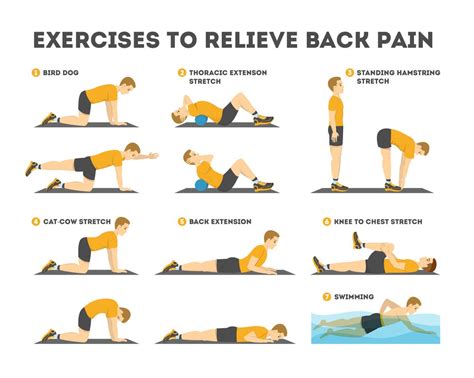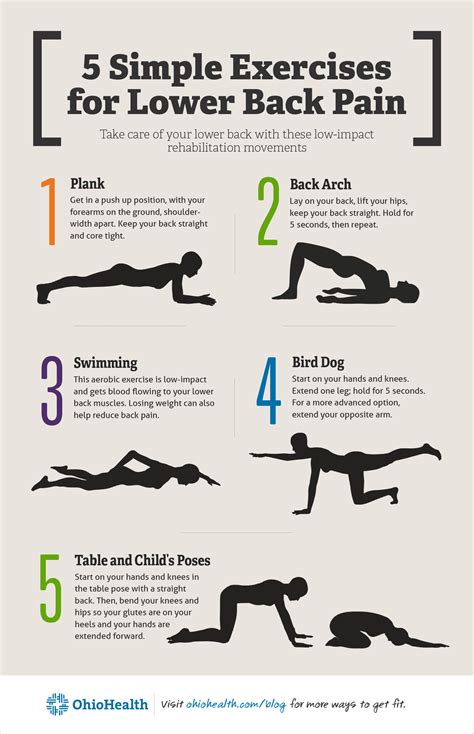Intro
Relieve back pain with 5 exercises that strengthen core muscles, improve posture, and reduce spinal stress, alleviating chronic discomfort and promoting a healthier back through gentle stretches and strengthening techniques.
Back pain is a common complaint that affects millions of people worldwide. It can be caused by a variety of factors, including poor posture, muscle strain, and underlying medical conditions. While there are many treatments available for back pain, exercise is one of the most effective ways to alleviate symptoms and improve overall spinal health. In this article, we will explore five exercises that can help ease back pain, as well as provide tips on how to incorporate them into your daily routine.
Back pain can have a significant impact on a person's quality of life, making everyday activities such as walking, sitting, and even sleeping a challenge. It can also lead to feelings of frustration, anxiety, and depression. However, by incorporating exercises that strengthen the back muscles and improve flexibility, individuals can reduce their risk of developing back pain and improve their overall well-being. Whether you are experiencing acute or chronic back pain, it is essential to consult with a healthcare professional before starting any new exercise program.
Exercise is a natural and non-invasive way to manage back pain, and it can be modified to suit different fitness levels and abilities. Regular exercise can help to strengthen the muscles that support the spine, improve posture, and increase flexibility. Additionally, exercise can help to reduce stress and anxiety, which are common triggers for back pain. By incorporating a combination of stretching, strengthening, and aerobic exercises into your daily routine, you can help to alleviate back pain and improve your overall health and well-being.
Understanding Back Pain

Back pain can be caused by a variety of factors, including poor posture, muscle strain, and underlying medical conditions. It can also be triggered by everyday activities such as lifting, bending, and twisting. Understanding the causes of back pain is essential in developing an effective treatment plan. By identifying the underlying causes of back pain, individuals can take steps to prevent future episodes and improve their overall spinal health.
Types of Back Pain
There are several types of back pain, including acute, chronic, and neuropathic pain. Acute back pain is characterized by sudden and severe pain, often caused by muscle strain or injury. Chronic back pain, on the other hand, is characterized by persistent and ongoing pain, often caused by underlying medical conditions such as arthritis or spinal stenosis. Neuropathic pain is characterized by shooting or burning pain, often caused by nerve damage or irritation.Exercise and Back Pain

Exercise is a critical component of back pain management. Regular exercise can help to strengthen the muscles that support the spine, improve posture, and increase flexibility. Additionally, exercise can help to reduce stress and anxiety, which are common triggers for back pain. By incorporating a combination of stretching, strengthening, and aerobic exercises into your daily routine, you can help to alleviate back pain and improve your overall health and well-being.
Benefits of Exercise for Back Pain
The benefits of exercise for back pain are numerous. Exercise can help to reduce pain and inflammation, improve mobility and flexibility, and strengthen the muscles that support the spine. Additionally, exercise can help to improve posture, reduce stress and anxiety, and enhance overall physical and mental well-being. By incorporating exercise into your daily routine, you can help to alleviate back pain and improve your overall quality of life.5 Exercises to Ease Back Pain

The following exercises can help to alleviate back pain and improve overall spinal health. Remember to consult with a healthcare professional before starting any new exercise program, especially if you have a pre-existing medical condition or concern.
- Pelvic Tilt: The pelvic tilt is a simple exercise that can help to stretch and strengthen the muscles in the lower back. To perform the pelvic tilt, lie on your back with your knees bent and feet flat on the floor. Tilt your pelvis upwards and then back down again, repeating the motion for 10-15 repetitions.
- Knee to Chest Stretch: The knee to chest stretch is a gentle exercise that can help to stretch the muscles in the lower back and hips. To perform the knee to chest stretch, lie on your back and bring one knee towards your chest. Hold the stretch for 30 seconds and then repeat on the other side.
- Cat-Cow Stretch: The cat-cow stretch is a gentle exercise that can help to stretch and strengthen the muscles in the neck and back. To perform the cat-cow stretch, start on your hands and knees. Arch your back and lift your tailbone towards the ceiling, then round your back and tuck your chin towards your chest. Repeat the motion for 10-15 repetitions.
- Bridge: The bridge is a strengthening exercise that can help to strengthen the muscles in the lower back and glutes. To perform the bridge, lie on your back with your knees bent and feet flat on the floor. Lift your hips towards the ceiling, squeezing your glutes and lower back muscles as you lift. Hold the position for 2-3 seconds and then lower back down, repeating the motion for 10-15 repetitions.
- Plank: The plank is a strengthening exercise that can help to strengthen the muscles in the core and back. To perform the plank, start in a push-up position with your hands shoulder-width apart and your body in a straight line from head to heels. Hold the position for 30-60 seconds, engaging your core and back muscles to support your body.
Tips for Incorporating Exercise into Your Daily Routine

Incorporating exercise into your daily routine can be challenging, but there are several tips that can help. Start by scheduling exercise into your daily planner or calendar, and treat it as a non-negotiable appointment. Find an exercise buddy or accountability partner to help motivate and support you. Start slowly and gradually increase the intensity and duration of your workouts. Finally, find exercises that you enjoy and that fit your lifestyle and preferences.
Creating a Home Workout Routine
Creating a home workout routine can be a convenient and effective way to incorporate exercise into your daily routine. Start by investing in a few pieces of basic equipment, such as a yoga mat, dumbbells, and resistance bands. Find a quiet and comfortable space in your home to workout, and schedule your workouts at the same time each day. You can also find a variety of free workout videos and tutorials online to help guide and motivate you.Conclusion and Next Steps

In conclusion, exercise is a critical component of back pain management. By incorporating a combination of stretching, strengthening, and aerobic exercises into your daily routine, you can help to alleviate back pain and improve your overall health and well-being. Remember to consult with a healthcare professional before starting any new exercise program, especially if you have a pre-existing medical condition or concern. With patience, persistence, and practice, you can take control of your back pain and improve your overall quality of life.
We hope this article has provided you with valuable information and insights on how to ease back pain through exercise. If you have any questions or comments, please don't hesitate to reach out. We would love to hear from you and help you on your journey towards a healthier and happier life.
What are the most common causes of back pain?
+Back pain can be caused by a variety of factors, including poor posture, muscle strain, and underlying medical conditions. It can also be triggered by everyday activities such as lifting, bending, and twisting.
How can exercise help to alleviate back pain?
+Exercise can help to alleviate back pain by strengthening the muscles that support the spine, improving posture, and increasing flexibility. Additionally, exercise can help to reduce stress and anxiety, which are common triggers for back pain.
What are some tips for incorporating exercise into my daily routine?
+Start by scheduling exercise into your daily planner or calendar, and treat it as a non-negotiable appointment. Find an exercise buddy or accountability partner to help motivate and support you. Start slowly and gradually increase the intensity and duration of your workouts. Finally, find exercises that you enjoy and that fit your lifestyle and preferences.
